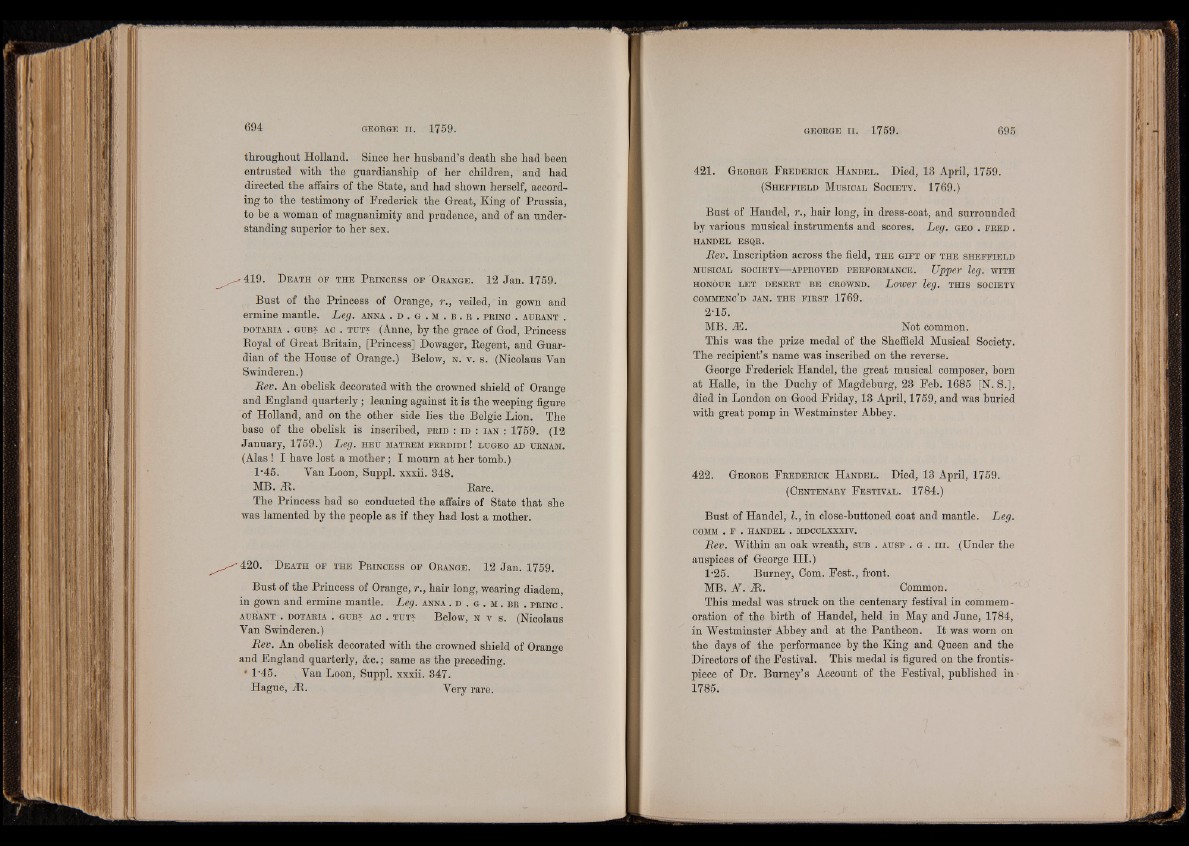
throughout Holland. Since her husband’s death she had been
entrusted with the guardianship of her children, and had
directed the affairs of the State, and had shown herself, according
to the testimony of Frederick the Great, King of Prussia,
to be a woman of magnanimity and prudence, and of an understanding
superior to her sex.
■ 419. D e a t h o f t h e P r in c e s s o f O r a n g e . 12 Jan. 1759.
Bust of the Princess of Orange, r., veiled, in gown and
ermine mantle. Leg. a n n a . d . g . m . b . r . p r in c . a u r a n t .
d o t a r ia . g u b ? ac . t u t ? (Anne, by the grace of God, Princess
Boyal of Great Britain, [Princess] Dowager, Regent, and Guardian
of the House of Orange.) Below, n . v . s . (Nicolaus Yan
Swinderen.)
Rev. An obelisk decorated with the crowned shield of Orange
and England quarterly; leaning against it is the weeping figure
of Holland, and on the other side lies the Belgic Lion. The
base of the obelisk is inscribed, p r id : id : ia n : 1759. (12
January, 1759.) Leg. h e u m a t r e m p e r d id i ! l u g e o a d u r n a m .
(Alas ! I have lost a mother; I mourn at her tomb.)
1'45. Yan Loon, Suppl. xxxii. 348.
MB. M. Rare.
The Princess had so conducted the affairs of State that she
was lamented by the people as if they had lost a mother.
420. D e a t h o f t h e P r in c e s s o f O r a n g e . 12 Jan. 1759.
Bust of the Princess of Orange, r., hair long, wearing diadem,
in gown and ermine mantle. Leg. a n n a . d . g . m . b r . p r in c .
aur'a n t . d o t a r ia . g u b ? ac . t u t ? Below, n v s. (Nicolaus
Yan Swinderen.)
Rev. An obelisk decorated with the crowned shield of Orange
and England quarterly, &c.; same as the preceding.
* 1'45. Van Loon, Suppl. xxxii. 347.
Hague, JR. Very rare.
421. G e o r g e F r e d e r ic k H a n d e l . Died, 13 April, 1759.
( S h e f f i e l d M u s ic a l S o c ie t y . 1769.)
Bust of Handel, r., hair long, in dress-coat, and surrounded
by various musical instruments and scores. Leg. g e o . f r e d .
HANDEL ESQR.
Rev. Inscription across the field, t h e g i f t o f t h e Sh e f f i e l d
m u s ic a l s o c ie t y— a p p r o v e d p e r f o r m a n c e . Upper leg. WITH
HONOUR LET DESERT BE CROWND. Lower leg. THIS SOCIETY
c o m m e n c ’d JAN. THE FIRST 1769.
2-15.
MB. 2E. Not common.
This was the prize medal of the Sheffield Musical Society.
The recipient’s name was inscribed on the reverse.
George Frederick Handel, the great musical composer, born
at Halle, in the Duchy of Magdeburg, 23 Feb. 1685 [N. S.],
died in London on Good Friday, 13 April, 1759, and was buried
with great pomp in Westminster Abbey.
422. G e o r g e F r e d e r ic k H a n d e l . Died, 13 April, 1759.
(C e n t e n a r y F e s t iv a l . 1784.)
Bust of Handel, I., in close-buttoned coat and mantle. Leg.
COMM . F . HANDEL . MDCCLXXXTV.
Rev. Within an oak wreath, s u b . a u s p . g . h i . (Under the
auspices of George III.)
1*25. Burney, Com. Fest., front.
MB. N . JR. Common.
This medal was struck on the centenary festival in commemoration
of the birth of Handel, held in May and June, 1784,
in Westminster Abbey and at the Pantheon. It was worn on
the days of the performance by the King and Queen and the
Directors of the Festival. This medal is figured on the frontispiece
of Dr. Burney’s Account of the Festival, published in
1785.